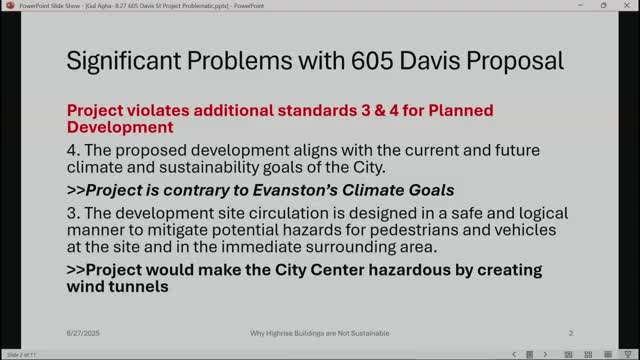Evanston Council Reviews High Rise Controversy Over Environmental Impact and Wind Safety
August 29, 2025 | Evanston, Cook County, Illinois
This article was created by AI summarizing key points discussed. AI makes mistakes, so for full details and context, please refer to the video of the full meeting. Please report any errors so we can fix them. Report an error »

In the heart of Evanston, city officials gathered for a Land Use Commission meeting that sparked intense discussions about the future of urban development and its environmental impact. As the sun set outside, the room buzzed with concerns over a proposed high-rise project that some residents believe could undermine the city’s sustainability goals.
A key speaker, a resident and condo board president, passionately argued against the project, citing alarming statistics about carbon emissions. He pointed out that buildings in Evanston contribute to 80% of the city’s greenhouse gas emissions, with high-rises producing more than double the emissions of low-rise structures. “Concrete is awful,” he stated, emphasizing that the materials used in construction significantly contribute to what is known as embodied carbon. He urged the commission to reconsider the environmental implications of the proposed high-rise, suggesting that even a modest six-story building would be more sustainable.
The speaker also raised concerns about the potential dangers posed by wind tunnels created by tall buildings, particularly in public spaces like Fountain Square, a central gathering place in Evanston. He highlighted that the wind study conducted for the project indicated that on 20% of summer days, conditions would be uncomfortable for pedestrians. “For frail individuals, it’s not advisable to walk at over 20 miles an hour,” he warned, calling for a more thorough analysis of how the project would affect vulnerable populations.
As the discussion unfolded, commissioners engaged with the speaker, seeking clarity on his claims and the data he presented. One commissioner noted the importance of balancing land use with environmental concerns, suggesting that the city must consider the limited developable land available. The speaker countered that while he supports development, it should not come at the expense of the environment or community safety.
The meeting concluded with a commitment from the commission to revisit the sustainability goals for the project. The speaker’s call for stricter energy efficiency standards and the use of environmentally friendly materials resonated with some members, who expressed a desire to strengthen the project’s sustainability requirements.
As the evening drew to a close, the future of Evanston’s skyline remained uncertain, but one thing was clear: the community is deeply invested in ensuring that growth aligns with environmental stewardship and public safety. The discussions at this meeting will likely shape the city’s development policies for years to come, as residents and officials alike grapple with the complexities of urban planning in an era of climate change.
A key speaker, a resident and condo board president, passionately argued against the project, citing alarming statistics about carbon emissions. He pointed out that buildings in Evanston contribute to 80% of the city’s greenhouse gas emissions, with high-rises producing more than double the emissions of low-rise structures. “Concrete is awful,” he stated, emphasizing that the materials used in construction significantly contribute to what is known as embodied carbon. He urged the commission to reconsider the environmental implications of the proposed high-rise, suggesting that even a modest six-story building would be more sustainable.
The speaker also raised concerns about the potential dangers posed by wind tunnels created by tall buildings, particularly in public spaces like Fountain Square, a central gathering place in Evanston. He highlighted that the wind study conducted for the project indicated that on 20% of summer days, conditions would be uncomfortable for pedestrians. “For frail individuals, it’s not advisable to walk at over 20 miles an hour,” he warned, calling for a more thorough analysis of how the project would affect vulnerable populations.
As the discussion unfolded, commissioners engaged with the speaker, seeking clarity on his claims and the data he presented. One commissioner noted the importance of balancing land use with environmental concerns, suggesting that the city must consider the limited developable land available. The speaker countered that while he supports development, it should not come at the expense of the environment or community safety.
The meeting concluded with a commitment from the commission to revisit the sustainability goals for the project. The speaker’s call for stricter energy efficiency standards and the use of environmentally friendly materials resonated with some members, who expressed a desire to strengthen the project’s sustainability requirements.
As the evening drew to a close, the future of Evanston’s skyline remained uncertain, but one thing was clear: the community is deeply invested in ensuring that growth aligns with environmental stewardship and public safety. The discussions at this meeting will likely shape the city’s development policies for years to come, as residents and officials alike grapple with the complexities of urban planning in an era of climate change.
View full meeting
This article is based on a recent meeting—watch the full video and explore the complete transcript for deeper insights into the discussion.
View full meeting
